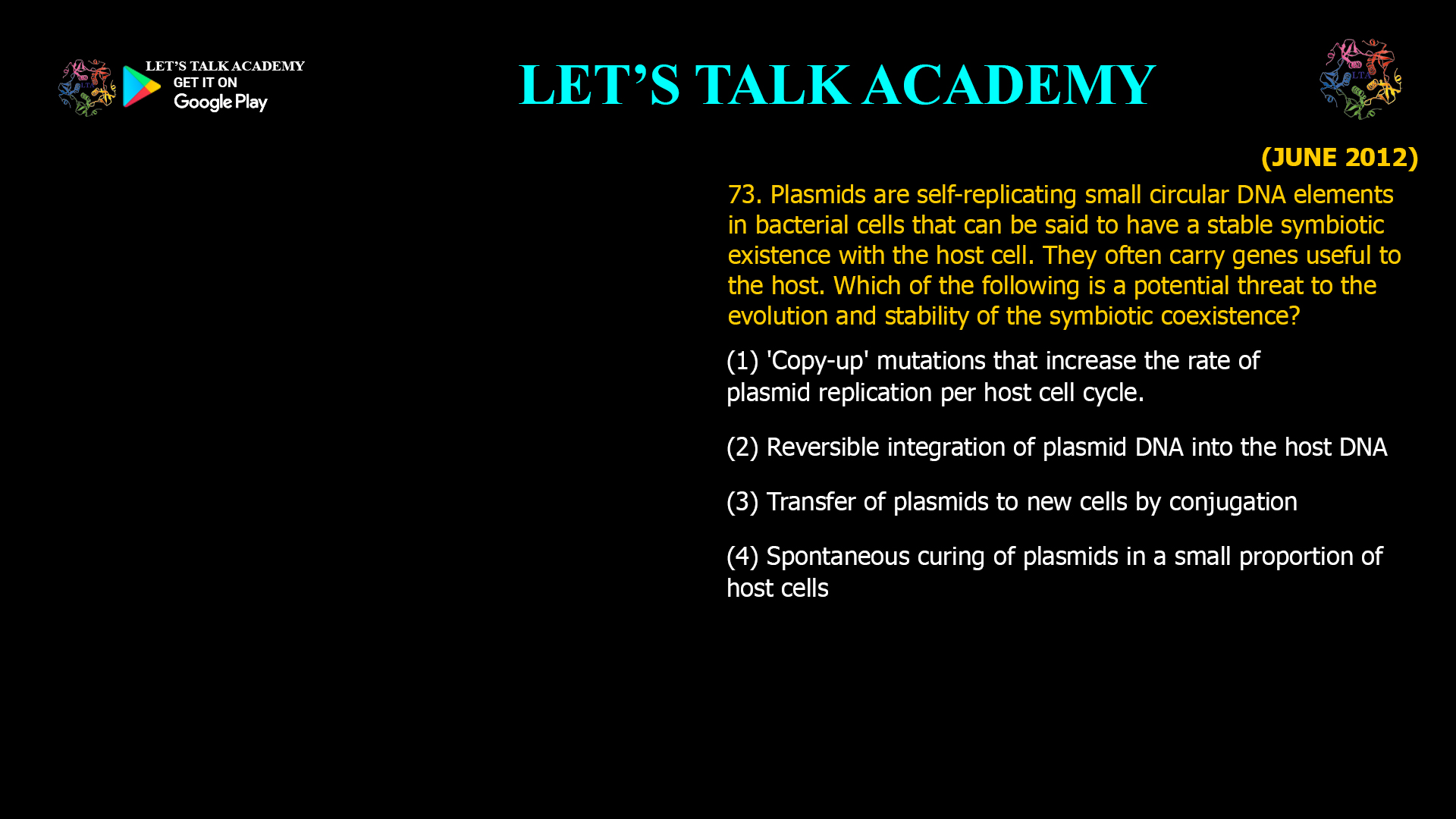- Plasmids are self-replicating small circular DNA elements in bacterial cells that can be said to have a stable symbiotic existence with the host cell. They often carry genes useful to the host. Which of the following is a potential threat to the evolution and stability of the symbiotic coexistence?
(1) ‘Copy-up’ mutations that increase the rate of plasmid replication per host cell cycle.
(2) Reversible integration of plasmid DNA into the host DNA
(3) Transfer of plasmids to new cells by conjugation
(4) Spontaneous curing of plasmids in a small proportion of host cellsPlasmids are small, self-replicating, circular DNA elements found in bacterial cells. They exist outside the main chromosome and often carry genes that provide useful traits, such as antibiotic resistance or new metabolic capabilities, enhancing the survival and adaptability of their host bacteria. This mutually beneficial relationship is a classic example of stable symbiotic coexistence in the microbial world.
However, the evolutionary stability of this relationship can be threatened by certain genetic changes, particularly those that disrupt the delicate balance between plasmid replication and host cell health. Among the potential threats, ‘copy-up’ mutations—which increase the rate of plasmid replication per host cell cycle—stand out as a significant risk to this symbiotic equilibrium.
How Plasmid-Host Symbiosis Works
For plasmids and their bacterial hosts to coexist stably, plasmid replication must be tightly regulated. Most plasmids encode specific proteins that initiate replication at defined origins and employ sophisticated mechanisms to ensure that their copy number remains within a range that does not burden the host cell. When this balance is maintained, plasmids can persist across generations without significantly impacting host fitness, and the host benefits from the traits encoded by the plasmid.
What Are ‘Copy-Up’ Mutations?
‘Copy-up’ mutations are genetic changes—often in the plasmid’s replication initiation protein—that lead to an increase in the number of plasmid copies per cell. These mutations disrupt the normal regulatory mechanisms that control plasmid copy number. Instead of maintaining a stable, low-to-moderate number of plasmids, the cell begins to accumulate excessive plasmid copies.
Why Are ‘Copy-Up’ Mutations a Threat?
-
Metabolic Burden: High plasmid copy numbers can impose a significant metabolic load on the host cell. The cell’s resources are diverted to replicating and maintaining plasmid DNA, which can slow growth and reduce competitiveness.
-
Reduced Host Fitness: As the host cell becomes less fit, it may be outcompeted by plasmid-free cells or cells with better-regulated plasmids, threatening the persistence of both host and plasmid.
-
Evolutionary Instability: If ‘copy-up’ mutants spread, the symbiotic relationship may break down, leading to plasmid loss or host extinction.
How Do Other Events Affect Plasmid Stability?
Let’s briefly consider the other scenarios:
-
Reversible Integration of Plasmid DNA into Host DNA: This process, also known as episome formation, can be reversible and does not necessarily threaten stability, as the plasmid can still be maintained in the population.
-
Transfer of Plasmids by Conjugation: Conjugation allows plasmids to spread to new hosts, often enhancing their evolutionary success and stability.
-
Spontaneous Curing of Plasmids: While spontaneous loss of plasmids (curing) in a small proportion of cells can occur, it usually does not threaten overall stability unless the rate is exceptionally high.
Conclusion
Among the options, ‘copy-up’ mutations that increase the rate of plasmid replication per host cell cycle pose the greatest threat to the evolution and stability of plasmid-host symbiosis. By overwhelming the host’s resources and reducing fitness, these mutations can destabilize the relationship, potentially leading to the loss of both plasmid and host in the long term.
Correct answer: (1) ‘Copy-up’ mutations that increase the rate of plasmid replication per host cell cycle.
-



